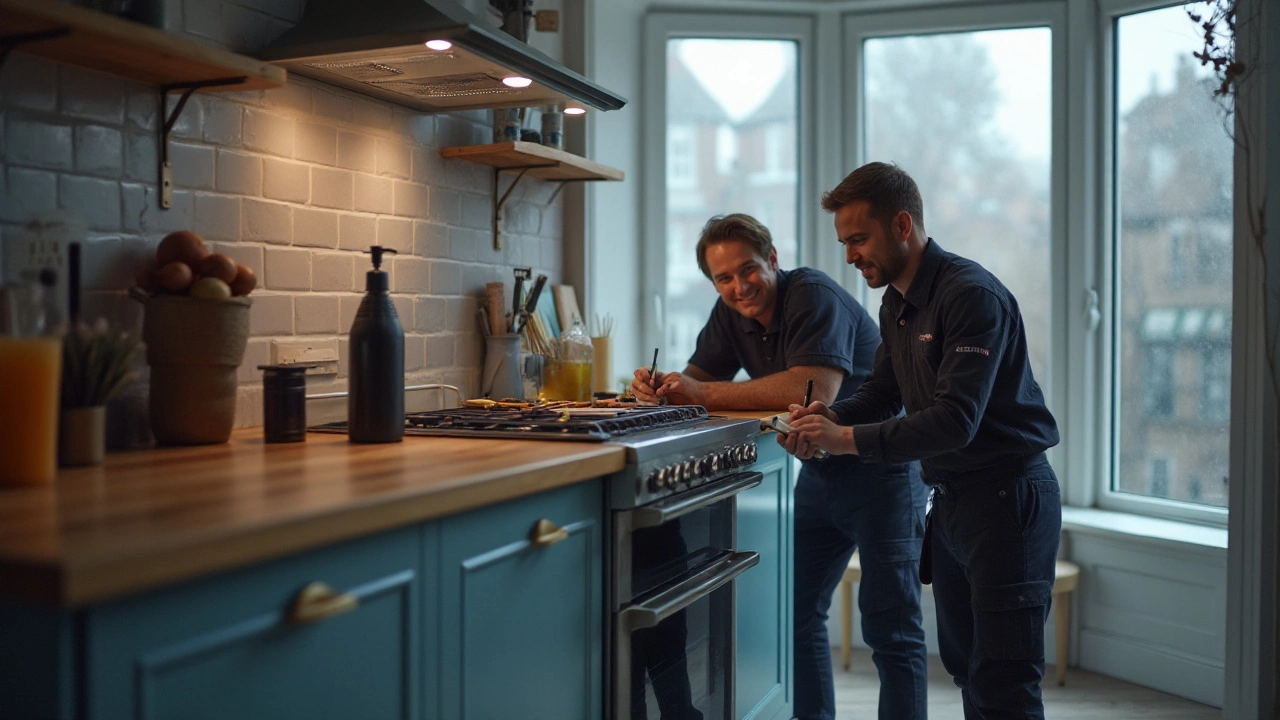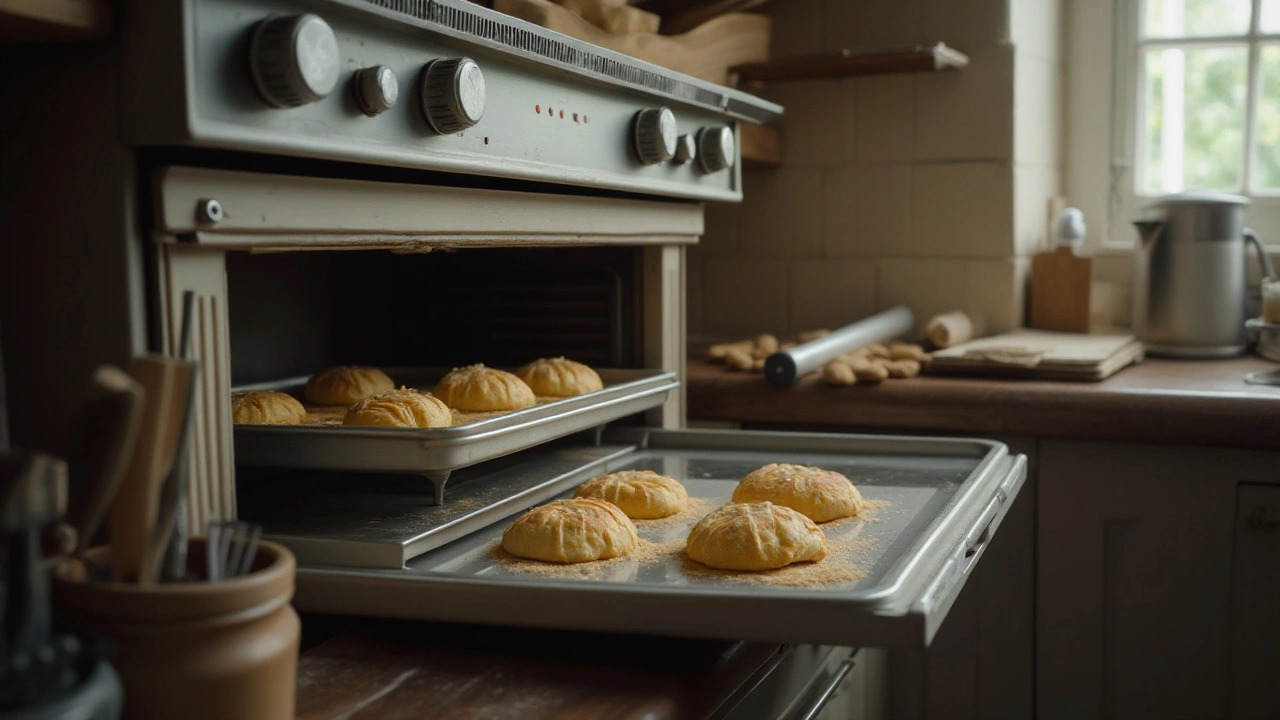Cooking with an electric oven should be a straightforward, satisfying process. Sometimes, though, things don't go quite as planned. Maybe your brownies aren't baking evenly, or your roasted chicken turns out unexpectedly raw—or worse, charred! These blunders can be more than just a ruined meal; they might hint that your oven needs a little TLC.
Understanding the signs that indicate your electric oven isn't performing as it should is crucial. Whether it's an obvious electrical issue or a more subtle malfunction, recognizing what these symptoms mean is essential. This can help you decide if it's something you can tackle alone or if calling a pro is the wise choice.
- Common Signs of a Broken Electric Oven
- Troubleshooting Oven Issues
- DIY Fixes for Minor Problems
- When to Call a Professional
Common Signs of a Broken Electric Oven
When it comes to identifying if your electric oven is on the fritz, there are specific signs that signify trouble. One of the most common complaints is uneven cooking. If you've noticed that your baked goods are raw on one side and overdone on the other, it's a tell-tale sign that the heating elements might be waning. The convection fan could also be faulty, disrupting the airflow and causing this imbalance in heat distribution. Pay attention to persistently occurring hot spots; they often indicate the same underlying issues.
Another prevalent problem is the oven's inability to reach or maintain the right temperature. You might set your oven to 180°C for a standard bake, only to find it not heating up at all or not reaching that temperature correctly. This can be due to a malfunctioning thermostat or a broken heating element, both essential components for the proper functioning of an oven. Broken oven signs like these not only ruin your dish but also waste energy, as the oven tries to reach the desired heat level.
Listen closely when your oven runs. If you detect strange noises—be it constant buzzing, unusual clicks, or whirring—it may mean mechanical parts are wearing out or that electrical components are failing. These noises often precede more significant breakdowns, spiraling into potentially dangerous electrical failures. Regular sound checks can help prevent these issues by catching them before they become serious.
Let’s not forget the control panel, the nerve center of your electric oven. If buttons are unresponsive or the display shows error codes, it's often a software or electrical issue. These problems can stem from power surges or simply age-related wear and tear. Error codes can sometimes be investigated and addressed with an owner’s manual, but persistent issues or unfamiliar codes may need a technician's input.
Culinary expert Chef Jamie Oliver once noted, "A kitchen is only as good as its tools." A malfunctioning oven not only comprised meal quality but also risks putting a damper on the creativity and joy of cooking.” To keep the culinary magic alive, regular maintenance and timely repairs are key.
Lingering odors can also tell tales of an oven in distress. If you catch the scent of burning plastic or acrid smoke when no food is cooking, it indicates melted wires or other internal damage, which needs immediate attention to avoid fire hazards. Similarly, erratic lights inside the oven or a door that won't seal properly further underscore operational issues, compromising both safety and performance.
In some cases, the signs are literally visible. If you notice burn marks or charring on the oven walls, pay attention. This damage often suggests malfunctioning components that might be causing excessive heat in an uneven way. Such visible cues are as critical as the food's taste since they point to potential safety risks that could grow if ignored.

Troubleshooting Oven Issues
Troubleshooting your electric oven might feel a little daunting at first, but understanding what’s going wrong can save a heap of trouble—and money—down the line. When your trusty appliance starts behaving erratically, it’s time to roll up those sleeves and get to the bottom of the issue. This process often begins with a close examination of the most common complaints: inconsistent heating, unresponsive controls, and strange noises. By methodically checking these factors, you might not only identify the problem but also work out a feasible solution.
If your oven isn’t heating properly, the first suspects are usually the heating elements. The bottom element, used for baking, or the top one, which helps in broiling, can malfunction due to wear and tear. Visual checks are crucial here—if there’s any visible damage, such as charring or breaks in the coil, a quick replacement might be all that’s needed. Sometimes, though, a malfunctioning thermostat could be to blame. This part controls the oven temperature, and if it’s faulty, the oven might not reach the desired heat level or shut off prematurely. Testing the thermostat with a multimeter can reveal whether it's working correctly.
Another common issue involves the oven door not sealing properly. A lot more can go wrong than it seems when the door seal is compromised; heat can escape, making the oven inefficient and cooking uneven. Inspect the gasket around the door for any wear or damage. Often, these seals are easy to replace and can dramatically improve your oven's performance. Similarly, if the controls aren’t responding as expected, attention might need to shift to the control panel or the knobs themselves. Burnt connections or faulty buttons might require replacement parts.
Let’s not overlook the issue of unexplained noises. If your oven is making unusual sounds, it might be time to dig deeper. Squealing or popping noises can indicate worn or loose parts. Pay attention to any loose screws or unstable racks inside the oven, which can be fixed simply with a screwdriver or by repositioning the internal racks correctly. A comprehensive manual should provide information on which noises signal a problem and which are normal during operation.
“In many cases, these malfunctioning parts can cause the oven to perform inconsistently or inefficiently, leading to uneven cooking and unexpected results. Addressing these issues promptly can save energy and extend the life of your appliance,” advises a top technician from a renowned appliance repair company.
To help organise your troubleshooting efforts, developing a checklist can be incredibly beneficial. Here’s a quick guide you can follow:
- Check for visible damage in heating elements.
- Test the oven thermostat with a multimeter.
- Inspect and possibly replace the door gasket if damaged.
- Ensure the oven racks and internal parts are securely fastened.
- Listen for unusual sounds and identify their origins.
Remember, when in doubt, consulting the user manual is always a good move. If these checks don’t resolve the problem, it might be wise to call in a professional, especially if electrical repairs are involved. Safety should always come first when dealing with appliances, so don’t hesitate to seek expert help if needed.

DIY Fixes for Minor Problems
When you find yourself facing a faulty electric oven, it's common to feel a mix of frustration and mystery, as if you're trying to solve a puzzle with a missing piece. Before you dial for an expensive professional service, let's dive into some practical and effective DIY fixes that can save both time and money. Many minor issues that occur with an electric oven are often due to user-related errors or easily rectified glitches. These are not only manageable but can also provide you with a sense of accomplishment and empowerment. So, let's roll up our sleeves and tackle some common challenges.
A significant yet often overlooked issue is when your electric oven starts cooking unevenly. This might mean your blueberry muffins are crisply done on the outside but remain raw on the inside. Start by checking if the oven racks are in the correct position, as it impacts the circulation of heat. Many times, even experienced cooks forget about this simple adjustment. Moreover, examine the heating elements—both the top broiler and the bottom element—for any visible damage or burnouts. A continuity test using a multimeter can help diagnose if they're functioning correctly. A useful tip: occasionally rotate your food mid-cooking to help even out the heat distribution.
Another nagging problem could be an electric oven that simply won't heat up at all. Begin by ensuring the oven is properly plugged in, and check if the circuit breaker hasn’t tripped. Often, the solution is as simple as flipping a switch! If this doesn't fix the problem, inspect the digital controls or manual dial settings. Setting the correct temperature is crucial, and sometimes high-tech models might need a reset, much like a smartphone. This can typically be done by turning off the oven at the breaker for about a minute and then turning it back on. Many oven enthusiasts will voice that less is more when it comes to setting overly complex controls.
Addressing light problems such as buzzing noises or strange metallic smells, the fix might be simpler than it appears. Cleanliness can’t be stressed enough. Many times, residues on the heating elements or accumulated grease can cause bizarre smells. Disassemble with care and clean the bottom and top elements gently with a vinegar-water mixture. Listen for any electrical buzzing, which might indicate a loose wire. But remember, safety first—always unplug your appliance when conducting any internal inspection.
Thermostat calibration can also disguise as a greater issue than it actually is. Neglecting correct calibration can indeed cause varied and unpredictable baking times. To check, purchase an inexpensive oven thermometer, set your oven to a standard temperature, such as 180°C (350°F), and after 15 minutes, measure the temperature against the reading. An adjustment may be easily made by following the instruction in your manual, often found online if misplaced. In the words of renowned culinary expert Julia Child,
“You don't have to cook fancy or complicated masterpieces—just good food from fresh ingredients.”Calibration ensures happy outcomes with fresh ingredients, preventing mishaps in achieving simple but delightful meals.
One more preventative maintenance tip pertains to removing and cleaning the oven door gasket, the part that seals in the heat. A loose or damaged gasket can lead to heat leaking out and inefficient cooking. Remove debris with a soft cloth or sponge, being gentle so as not to cause further wear or tear. By following these tips and techniques, you can effectively address some of the minor setbacks you might encounter with your electric oven. Repairing minor faults by yourself is not only cost-effective but builds a deeper connection with your appliance, making each use more personal and satisfying.

When to Call a Professional
There comes a time in every home repair enthusiast's life when the wisest move is to step back and let the pros take over. As handy as you might be with a wrench or screwdriver, electric ovens present a blend of electrical complexity and mechanical trickery that can stump even seasoned DIYers. If your beloved kitchen appliance starts giving you grief, you might find yourself wondering when it's truly necessary to call in a skilled technician.
One clear sign is when the issue involves the electrical system. Electric ovens run on powerful currents, and messing about inside them without the proper precautions is downright hazardous. If your oven trips the circuit breaker consistently or fails to power on entirely due to electrical issues, that's a warning flag. Electric disruptions could signal anything from faulty wiring to a bad heating element. Navigating these waters without the right know-how could not only damage your oven further but could also compromise your home's safety.
Sometimes the problem might not present itself as a straightforward electrical issue, but as a malfunction with controls or sensors. Modern ovens often have digital displays and controls that can fail spectacularly. If buttons or knobs don’t respond as they should, or if the oven's temperature is wildly inconsistent, it might be an indication that the digital touchpad or thermostat needs professional attention. These components are integral to tuning the perfect temperature, and their accuracy is critical to successful cooking.
Notably, less apparent problems, such as strange noises or odd smells coming from your oven, are also indicators that a call to a professional is in order. Whirring sounds might suggest a failing fan motor, while burnt odors could be due to faulty wiring or even damaged seals. Diagnosing these issues accurately requires the practiced eye and expertise a professional can provide. An experienced repair person has access to specialized tools and diagnostic equipment, and can often identify and fix the problem more efficiently than a home attempt might.
Moreover, turning to professionals isn't merely about fixating on 'whether you can handle the repair', but also recognizing that a repairman can maintain and potentially extend your oven's lifespan. According to a report by the International Association of Certified Home Inspectors, proper maintenance and professional checks can extend the average lifespan of kitchen appliances by approximately 10%. Peace of mind and efficiency in your kitchen are worth the modest investment.
Finally, for those still on the fence, always remember that tinkering with your home appliances without sufficient knowledge can nullify warranties. Every appliance comes with a warranty that often specifies that repairs must be conducted by authorized service providers. Violate this, and you could end up paying out of pocket for more than just the repair.
"Home appliance warranties exist not just as a safety net for homeowners but as a reminder of the systems' complexity," says Martin Wells, a seasoned appliance repair technician. "Leaving repairs to those familiar with these machines is almost always best."
In the labyrinth of home appliance repairs, engaging a professional can save time, preserve safety, and ultimately uphold the integrity of your electric oven. Whether it's fixing intricate electronic components, addressing complex electrical faults, or simply providing a much-needed maintenance check, these experts help ensure your 'fix it' job doesn't morph into a 'replace it' dilemma.

I am an expert in the services industry with a focus on appliance repair. My passion lies in understanding how things work and educating others in simple, engaging ways. This enthusiasm fuels my writing, where I delve into topics around appliance maintenance and troubleshooting. I aim to make these subjects clear and accessible to all readers.